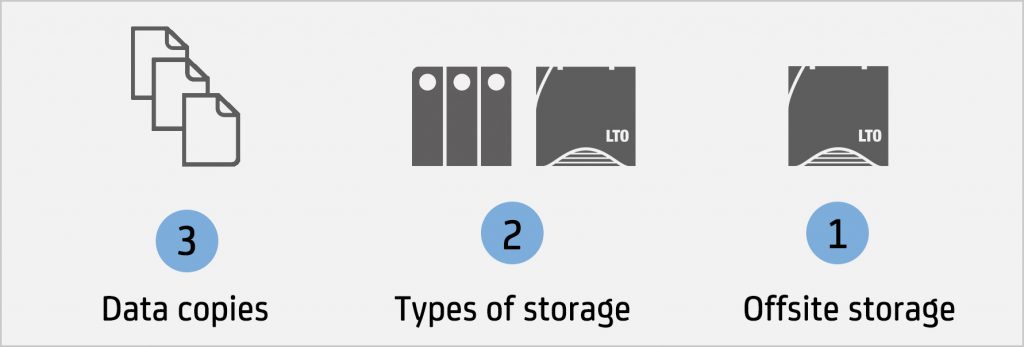
By David Fox
When it comes to assessing whether your current backup strategy is fit for purpose, a solid guideline is the time-honoured 3-2-1 backup rule.
The 3-2-1 Backup Rule
It states that three copies of your primary data should be maintained. Two copies should be on-site and a third off-site.
The first two copies include the ‘live’ copy of the data and one backup. Typically this backup will be made to either disk or LTO tape, some will already use cloud storage.
In this spotlight article, we’ll explore how the third, off-site backup, might be best served by using a low-cost cloud vendor’s storage. This low-cost cloud storage is fundamentally different to the instantly accessible cloud storage often used for other tasks, and we’ll explore why.
With ransomware attacks continuing to cause havoc for businesses, a cloud backup can also serve as the ransomware-proof part of the backup workflow. Cloud vendors offer ‘immutable’ settings when storing data, meaning malicious attempts to remove or scramble your cloud data will fail, and backups remain secure.

The Backup of Last Resort
In recent years, some cloud vendors have released ‘archive-class’ cloud storage which is specifically targeted at a use case where ‘cold’ data needs to be stored but is unlikely to be accessed. The storage has a low storage cost (per TB per month) but a higher than usual price for accessing and downloading data. This type of storage may be ideal for this third backup in the 3-2-1 strategy.
When we view this cloud backup, as the ‘insurance policy’ backup or ‘backup of last resort’, then using this cold archive storage, in return for lower costs, makes sense. The intention is that this cloud backup will only be restored if all other means of restoring data in the event of data-loss, fail. Given this should be an unlikely event, higher restore costs from the cloud vendor will likely never be paid. However, if all other backups fail, then the costs will be a palatable downside, in return for getting crucial business data back.
Low-Cost Cloud Storage
At the time of writing, AWS Glacier Archive storage and Microsoft Azure Archive Blob Storage are the two cheapest cloud storage services, specifically targeted at this use-case. Both are intended for ‘rarely accessed data that is stored for at least 180 days and can tolerate several hours of retrieval latency’. This means you’ll pay for at least 6 months of storage for any object that is stored and if you need to retrieve data, as part of restoring from a backup, you’ll need to wait several hours before your data is available to download.
Both of these cloud storage services are priced at around USD 0.99 per TB of data stored, per month. This is a very low per-TB cost for cloud storage.

However, in addition to the restrictions already stated, you’ll also need to pay additional download fees should you need to recover the data. These fees are somewhat complex to calculate as they depend upon the quantity of data, the number of individual files and additional charges for passing the data onto the internet for download. Running through the pricing specifics are beyond the scope of this article, but the fees are large enough that you’ll want to avoid them, except in dire emergencies! There are on-line price calculators that allow a quote for specific use cases which you should investigate before proceeding.
Backup + Cloud, a good combination?
If we’re comfortable with a cloud backup which we’re treating as an insurance policy and we don’t intend to use, then the cloud storage discussed above makes sense. Even with relatively large amounts of data to backup, the storage costs are palatable.
The topic is all about trade-offs and therefore calculations need to be made to determine the benefits.
Implementation
Since the provision of storage, cooling, power, hardware replacement etc is being outsourced to the cloud vendor, only the on-premise software setup needs to be taken care of to get the backup up and running.
When using Archiware P5 Backup, both on-prem backups to LTO and disk can be managed alongside an independent cloud backup. Setup simply requires selection of the source data, input of the credentials to access the cloud storage, and choosing the days/hours the backup should run. P5 has the benefit that all software configuration is also stored on the cloud storage, so the entire P5 setup can be recovered from the cloud storage if needed.
Conclusions
If you currently have a backup strategy that could potentially fail due to local impacts, you need an additional backup. Your building could become a single point of failure, if you have your primary storage and backups sharing the same location. A disk-based backup could be subject to a ransomware attack.
Can you imagine a scenario where primary storage fails and so does the backup? If so, a cloud backup is simple to set up. It’s also relatively cheap if you can understand and tolerate the trade-offs.
Archiware P5 Backup provides the perfect software solution for onsite disk/tape backups but also an independent cloud backup (of last resort).

